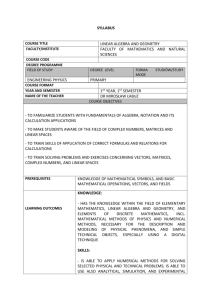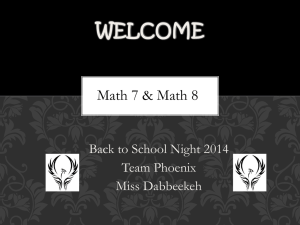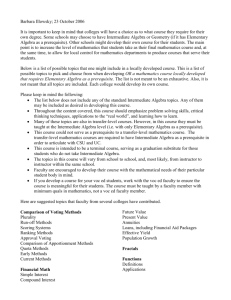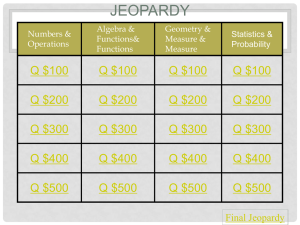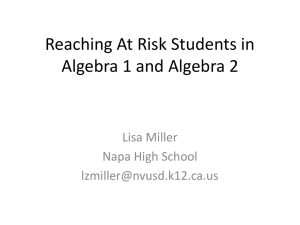Kindergarten
advertisement
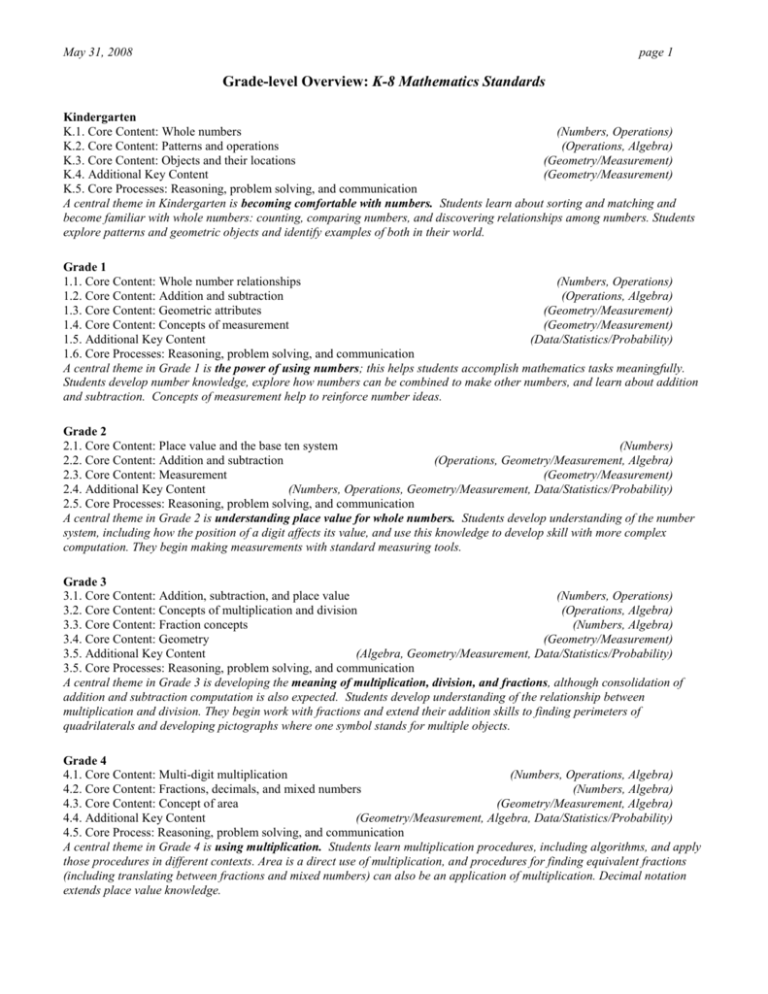
May 31, 2008 page 1 Grade-level Overview: K-8 Mathematics Standards Kindergarten K.1. Core Content: Whole numbers (Numbers, Operations) K.2. Core Content: Patterns and operations (Operations, Algebra) K.3. Core Content: Objects and their locations (Geometry/Measurement) K.4. Additional Key Content (Geometry/Measurement) K.5. Core Processes: Reasoning, problem solving, and communication A central theme in Kindergarten is becoming comfortable with numbers. Students learn about sorting and matching and become familiar with whole numbers: counting, comparing numbers, and discovering relationships among numbers. Students explore patterns and geometric objects and identify examples of both in their world. Grade 1 1.1. Core Content: Whole number relationships (Numbers, Operations) 1.2. Core Content: Addition and subtraction (Operations, Algebra) 1.3. Core Content: Geometric attributes (Geometry/Measurement) 1.4. Core Content: Concepts of measurement (Geometry/Measurement) 1.5. Additional Key Content (Data/Statistics/Probability) 1.6. Core Processes: Reasoning, problem solving, and communication A central theme in Grade 1 is the power of using numbers; this helps students accomplish mathematics tasks meaningfully. Students develop number knowledge, explore how numbers can be combined to make other numbers, and learn about addition and subtraction. Concepts of measurement help to reinforce number ideas. Grade 2 2.1. Core Content: Place value and the base ten system (Numbers) 2.2. Core Content: Addition and subtraction (Operations, Geometry/Measurement, Algebra) 2.3. Core Content: Measurement (Geometry/Measurement) 2.4. Additional Key Content (Numbers, Operations, Geometry/Measurement, Data/Statistics/Probability) 2.5. Core Processes: Reasoning, problem solving, and communication A central theme in Grade 2 is understanding place value for whole numbers. Students develop understanding of the number system, including how the position of a digit affects its value, and use this knowledge to develop skill with more complex computation. They begin making measurements with standard measuring tools. Grade 3 3.1. Core Content: Addition, subtraction, and place value (Numbers, Operations) 3.2. Core Content: Concepts of multiplication and division (Operations, Algebra) 3.3. Core Content: Fraction concepts (Numbers, Algebra) 3.4. Core Content: Geometry (Geometry/Measurement) 3.5. Additional Key Content (Algebra, Geometry/Measurement, Data/Statistics/Probability) 3.5. Core Processes: Reasoning, problem solving, and communication A central theme in Grade 3 is developing the meaning of multiplication, division, and fractions, although consolidation of addition and subtraction computation is also expected. Students develop understanding of the relationship between multiplication and division. They begin work with fractions and extend their addition skills to finding perimeters of quadrilaterals and developing pictographs where one symbol stands for multiple objects. Grade 4 4.1. Core Content: Multi-digit multiplication (Numbers, Operations, Algebra) 4.2. Core Content: Fractions, decimals, and mixed numbers (Numbers, Algebra) 4.3. Core Content: Concept of area (Geometry/Measurement, Algebra) 4.4. Additional Key Content (Geometry/Measurement, Algebra, Data/Statistics/Probability) 4.5. Core Process: Reasoning, problem solving, and communication A central theme in Grade 4 is using multiplication. Students learn multiplication procedures, including algorithms, and apply those procedures in different contexts. Area is a direct use of multiplication, and procedures for finding equivalent fractions (including translating between fractions and mixed numbers) can also be an application of multiplication. Decimal notation extends place value knowledge. May 31, 2008 page 2 Grade 5 5.1. Core Content: Multi-digit division (Operations, Algebra) 5.2. Core Content: Addition and subtraction of fractions and decimals (Numbers, Operations, Algebra) 5.3. Core Content: Triangles and quadrilaterals (Geometry/Measurement, Algebra) 5.4. Core Content: Representations of algebraic relationships (Operations, Geometry/Measurement, Algebra) 5.5. Additional Key Content (Numbers, Data/Statistics/Probability) 5.6. Core Process: Reasoning, problem solving, and communication A central theme in Grade 5 is relating division and fractions. Students consolidate their computation skills by learning procedures for division of multi-digit numbers and for adding and subtracting fractions and decimals. Working with algebraic relationships helps extend understanding of the properties of numbers and operations. Grade 6 6.1. Core Content: Multiplication and division of fractions and decimals (Numbers, Operations, Algebra) 6.2. Core Content: Mathematical expressions and equations (Operations, Algebra) 6.3. Core Content: Ratios, rates and percents (Numbers, Operations, Geometry/Measurement, Algebra, Data/Statistics/Probability) 6.4. Core Content: Two- and three-dimensional figures (Geometry/Measurement, Algebra) 6.5. Additional Key Content (Numbers, Operations) 6.6. Core Process: Reasoning, problem solving, and communication A central theme in Grade 6 is proportional reasoning. Students begin to develop multiplicative and proportional reasoning. Ratios, rates, and percents, as well as study of two- and three-dimensional figures, support understanding of proportions. Students are introduced to variables, one-step equations, and graphing of simple functions. Grade 7 7.1. Core Content: Rational numbers and linear equations (Numbers, Operations, Algebra) 7.2. Core Content: Proportionality and similarity (Operations, Geometry/Measurement, Algebra) 7.3. Core Content: Surface area and volume (Geometry/Measurement) 7.4. Core Content: Probability and data (Data/Statistics/Probability) 7.5 Additional Key Content (Numbers, Algebra) 7.6. Core Processes: Reasoning, problem solving, and communication A central theme in Grade 7 is application of proportions. Students learn about proportions (i.e., a proportion is the equating of two ratios) and apply that knowledge. Procedures for computing surface area and volume and study of probability provide opportunities to use proportions. Negative numbers are introduced to extend number sense to all rational numbers; this is critical for algebraic reasoning. Students solve two-step equations and learn different ways to display data. Grade 8 8.1. Core Content: Linear functions and equations (Algebra) 8.2. Core Content: Properties of geometric figures (Numbers, Geometry/Measurement) 8.3. Core Content: Summary and analysis of data sets (Algebra, Data/Statistics/Probability) 8.4. Additional Key Content (Numbers, Operations) 8.5. Core Processes: Reasoning, problem solving, and communication A central theme in Grade 8 is algebraic thinking. Students consolidate their understanding of multiplicative and proportional reasoning and apply these ideas to fundamental concepts of algebra. Techniques for summarizing and analyzing data are further developed and comparison of two data sets with unequal numbers of data elements provides a sophisticated application of proportions. Study of linear functions helps students generalize their understanding of proportions to situations involving linear relationships that are not proportional.

